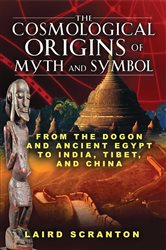
The Cosmological Origins of Myth and Symbol | Free Book

From the Dogon and Ancient Egypt to India, Tibet, and China
Reconstructs a theoretic parent cosmology that underlies ancient
religion
• Shows how this parent cosmology provided the conceptual origins of written language
• Uses techniques of comparative cosmology to synchronize the creation traditions of the Dogon, ancient Egyptians, and ancient Buddhists
• Applies the signature elements of this parent cosmology to explore and interpret the creation tradition of a present-day Tibetan/Chinese tribe called the Na-Khi--the keepers of the world’s last surviving hieroglyphic language
Great thinkers and researchers such as Carl Jung have acknowledged the many broad similarities that exist between the myths and symbols of ancient cultures. One largely unexplored explanation for these similarities lies in the possibility that these systems of myth all descended from one common cosmological plan. Outlining the most significant aspects of cosmology found among the Dogon, ancient Egyptians, and ancient Buddhists, including the striking physical and cosmological parallels between the Dogon granary and the Buddhist stupa, Laird Scranton identifies the signature attributes of a theoretic ancient parent cosmology--a planned instructional system that may well have spawned these great ancient creation traditions.
Examining the esoteric nature of cosmology itself, Scranton shows how this parent cosmology encompassed both a plan for the civilized instruction of humanity as well as the conceptual origins of language. The recurring shapes in all ancient religions were key elements of this plan, designed to give physical manifestation to the sacred and provide the means to conceptualize and compare earthly dimensions with those of the heavens. As a practical application of the plan, Scranton explores the myths and language of an obscure Chinese priestly tribe known as the Na-Khi--the keepers of the world’s last surviving hieroglyphic language. Suggesting that cosmology may have engendered civilization and not the other way around, Scranton reveals how this plan of cosmology provides the missing link between our macroscopic universe and the microscopic world of atoms.
• Shows how this parent cosmology provided the conceptual origins of written language
• Uses techniques of comparative cosmology to synchronize the creation traditions of the Dogon, ancient Egyptians, and ancient Buddhists
• Applies the signature elements of this parent cosmology to explore and interpret the creation tradition of a present-day Tibetan/Chinese tribe called the Na-Khi--the keepers of the world’s last surviving hieroglyphic language
Great thinkers and researchers such as Carl Jung have acknowledged the many broad similarities that exist between the myths and symbols of ancient cultures. One largely unexplored explanation for these similarities lies in the possibility that these systems of myth all descended from one common cosmological plan. Outlining the most significant aspects of cosmology found among the Dogon, ancient Egyptians, and ancient Buddhists, including the striking physical and cosmological parallels between the Dogon granary and the Buddhist stupa, Laird Scranton identifies the signature attributes of a theoretic ancient parent cosmology--a planned instructional system that may well have spawned these great ancient creation traditions.
Examining the esoteric nature of cosmology itself, Scranton shows how this parent cosmology encompassed both a plan for the civilized instruction of humanity as well as the conceptual origins of language. The recurring shapes in all ancient religions were key elements of this plan, designed to give physical manifestation to the sacred and provide the means to conceptualize and compare earthly dimensions with those of the heavens. As a practical application of the plan, Scranton explores the myths and language of an obscure Chinese priestly tribe known as the Na-Khi--the keepers of the world’s last surviving hieroglyphic language. Suggesting that cosmology may have engendered civilization and not the other way around, Scranton reveals how this plan of cosmology provides the missing link between our macroscopic universe and the microscopic world of atoms.
In The Press
“Following up and synthesizing his last two books, The Science of the Dogon, and Sacred Symbols of the Dogon, Laird Scranton’s latest book makes a good case that what we call today the myths and symbols of ancient peoples have not only cosmology as their basis but they originated from one “parent” cosmology. . . most fascinating study. . . ”
Also read:
- Title: The Cosmological Origins of Myth and Symbol | Free Book
- Author: Steven
- Created at : 2024-12-20 17:03:06
- Updated at : 2024-12-21 19:27:46
- Link: https://novels-ebooks.techidaily.com/95782149-9781594778896-the-cosmological-origins-of-myth-and-symbol/
- License: This work is licensed under CC BY-NC-SA 4.0.
